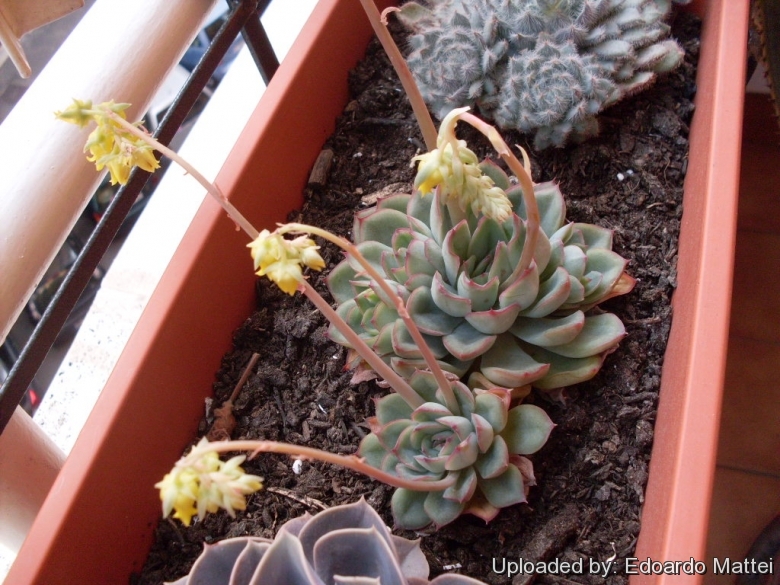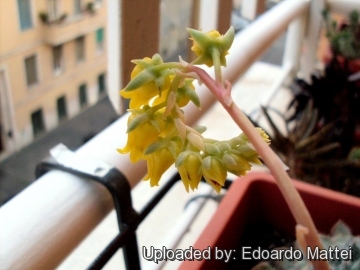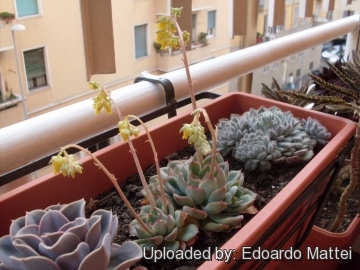




Your support is critical to our success.

Origin and Habitat: Mexico (North America) Originally thought to be from Hidalgo, more currently the origin is thought to be from near Beristain in the State of Puebla to the south. Plants of this species collected by Eric Walther from Necaxa in Puebla were distributed in 1963 by the International Succulent Institute (ISI) and much of the cultivated material can be traced back to this release.
Synonyms:
- Echeveria pulidonis E.Walther
ENGLISH: Pulido's echeveria
RUSSIAN (Русский): Эxеверия пулидонис
Description: Echeveria pulidonisSN|21883]]SN|27641]] is a slow growing succulent with frosty blue spoon-shaped leaves outlined with rose-red margins. It has a very geometric form before the creation of his many offsets. In spring the bright yellow bell-shaped flowers tip arching reddish stems that bend over with the weight of the flowers.
Stems: Very short up to 2 cm long and 1cm across.
Roots: Short and fine.
Rosettes: Apparently stemless,10 to 14 cm wide of many (25 or more) leaves. Though often seen as solitary, it will offset to form a good size clump over time.
Leaves: Approx. 5 cm long and 1.5 cm broad, fleshy, ascending, oblong to ovate, incurved, tapering to the base, slightly concave above, convex below, bristle-tipped. light green, margins with a distinct red tip. The leaves take a characteristic purple-red tinge especially in time of drought and in winter.
Inflorescence: Usually unbranched cymose, shaped like a "shepherd's crook". Flowers nodding, 10 or more to each one-sided raceme. Flowering-stalkup to 20 cm tall, reddish. Bracts 1.4-1.6 cm long.
Flowers: Sepals to 6 mm long, triangular to ovate, pointed, spreading: corolla 9-10 mm, lemon-yellow, 5-sided. narrowing slightly at mouth.
Blooming season: Spring—summer.
Taxonomy: Echeveria pulidonis is placed in the series Urbiniae within the genus Echeveria. This series includes the nominate species, Echeveria agavoidesSN|27056]]SN|14325]], Echeveria elegansSN|14325]]SN|27056]], Echeveria halbingeri, and Echeveria lilacinaSN|27641]]SN|21883]].
Bibliography: Major referencens and further lectures
1) Eric Walther “Echeveria” California Academy of Sciences, 1972
2) John Pilbeam “The Genus Echeveria” British Cactus & Succulent Society, 2008
3) James Cullen, Sabina G. Knees, H. Suzanne Cubey “The European Garden Flora Flowering Plants:A Manual for the Identification of Plants Cultivated in Europe, Both Out-of-Doors and Under Glass” Cambridge University Press, 11/ago/2011
4) Werner Rauh “The Wonderful World of Succulents: Cultivation and Description of Selected Succulent Plants Other Than Cacti” Smithsonian Institution Press, 1984
5) L. Carruthers and R. Ginns “Echeverias: A Guide to Cultivation and Identification of the Popular American Succulents” Arco Publishing Company, Inc.; First Edition edition 1973

Echeveria pulidonis Photo by: Edoardo Mattei

Echeveria pulidonis Photo by: Edoardo Mattei
Cultivation and Propagation: Echeveria pulidonis is certainly one of the most versatile neat, low-growing rosette forming succulents. It is easy to care for and is a good starting point for beginning gardeners. It makes a great accent plant for any collection or planting.
Growth rate: This echeveria variety is a slow grower, that grows mainly in spring and autumn and will form beautiful clumps with time.
Soil: In habitat, many Echeverias grow on rocky outcroppings at higher altitudes. In this habitat, the water drains quickly away from the roots of the plant, never allowing the plant to remain waterlogged. For this reason, it is essential in cultivation to use a very porous soil, which will allow quick drainage.
Exposition: Bright light is required to prevent "stretching" of Echeverias ("stretching" occurs when a plant such as an Echeveria, is grown in dim light or over-fertilized, which causes overly lush growth that contributes to weak, pallid plants). Bright light enhances red edges.
Watering: Water thoroughly when soil is dry to the touch. Water sparingly in winter. A well-drained soil allows this plant to thrive getting winter rain.
Hardiness: It thrives in Mediterranean and subtropical climates. It likes warmth and is a bit more frost sensitive than most, (recommended minimum winter temperature 5° C) however plants kept perfectly dry can can survive at – 4° (-8° ?) C during short cold spell if very dry. On temperate regions it is grown under glass with heat.
Uses: It is cultivated as an ornamental plant for rock gardens planting, or as a potted plant. The low-growing clusters are very suitable to fill rock crevices. It is sometime used to cover the roof tiles of a house‐top. A layer of rosettes stapled to the roof overhang is used to hold an inch of peaty soil to the roof. It also used to form silvery blue small borders and are believed to keep away evil spirits. Mature clusters of rosette cascading from containers provide sculptural.
Pest:** Mealybugs.
Propagation:*** Quite easy from leaf cuttings and offsets.
| Your Actions | |
|---|---|
| Back to Echeveria index | |
| Back to Crassulaceae index | |
 |
Back to Succulents Encyclopedia index |
Privacy stantement - Terms and conditions - How to cite - About us - Feedback - Donate



